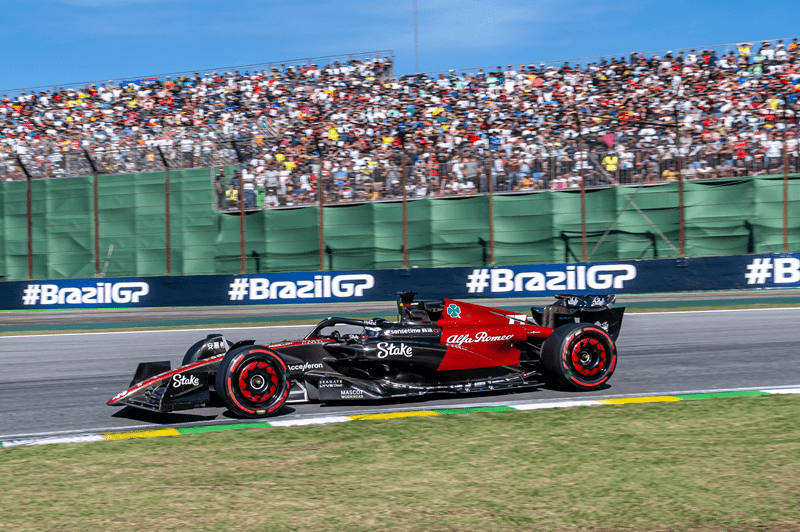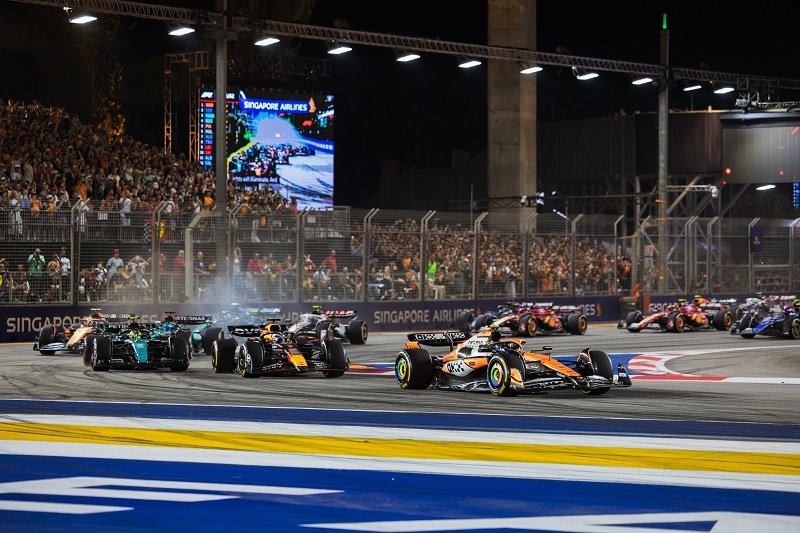Complete Guide to the 2025 F1 Season – Line-Up & Calendar

Fans and teams both are preparing for a year of fascinating changes in driver rosters, a rebuilt race calendar, and new rules meant to improve the competitive scene as the 2025 F1 season gets underway. Promising an interesting dynamic, notable changes in the driver line-up include iconic drivers transferring to new teams and gifted rookies starting the grid.
Aimed at lowering Formula 1's carbon footprint by minimising travel between continents, the 2025 season also brings a new geographic organisation of the race schedule. These changes uphold the excitement of international racing while reflecting the dedication of the sport to sustainability. The modifications are a suitable tribute to Formula 1's ongoing legacy since the 2025 season also marks the 75th anniversary of the sport. This makes Formula 1 a major year in news.
Complete Driver Roster for the F1 Season 2025
The F1 driver line-up for 2025 combines seasoned pros, well-known names, and bright fresh talent. Seven-time World Champion Lewis Hamilton joins Ferrari in one of the most talked about moves of the season, teamed with Charles Leclerc and leaving his Mercedes seat after almost ten years. This change upsets assumptions for the championship fight and generates an interesting dynamic for Ferrari. Carlos Sainz replaces Hamilton's former position at Williams, a move meant to raise the team's aspirations in the midfield struggle.
Mercedes has also brought fresh talent to its lineup: Andrea Kimi Antonelli, a Formula 2 driver with great aptitude and flexibility. Antonelli's attendance with George Russell shows Mercedes's approach of developing new talent and confidence in his capacity to fit the Formula 1 stage. Oliver Bearman, a reserve driver for Ferrari who joins Haas following great performance, and Esteban Ocon, who also moves to Haas, create a dynamic line-up. Teams confirming their line-ups as they get ready for a competitive season ahead display the combination of experience and fresh energy in the 2025 grid.
List of the F1 Calendar and Venues for 2025
The F1 calendar 2025 is set out as a 24-race calendar with a mix of contemporary tracks and historic venues. Opening in Australia for the first time since 2019, the Melbourne Grand Prix sets the tone for the season. By arranging races by region to simplify logistics and lower environmental effect, this schedule also shows a more considered approach to regional alignment. For example, the season's first leg will consist of back-to-back races in Australia, China, and Japan, so reducing the distance between sites.
Two notable date changes are the rescheduling of the Bahrain and Saudi Arabian Grands Prix resulting from Ramadan in March. These races today fall in mid-April, which facilitates a more fluid race flow. The Hungarian Grand Prix in July and the Dutch Grand Prix in late August will bookend the summer break as the season unfolds, giving teams and supporters a strategically scheduled interval. This Grand Prix calendar offers an interesting flow of events, so helping teams control the pressures of a full calendar and combining legacy with sustainability.
Sprint Race Calendar and Format for 2025
Six sprint events scheduled for the 2025 F1 season will also be positioned deliberately to boost fan involvement and provide race weekend intensity. Notably added to the sprint calendar are Spa, where sprint races have made first-time returns since 2023. Given Spa's reputation for dramatic racing, this decision gives the Belgian Grand Prix a fresh degree of thrills. Miami, Interlagos, and Qatar are other sprint hosts; each site was chosen to best test driver performance and spectator delight.
Sprint events replace Friday's qualifying session with sprint qualifying, therefore changing conventional race weekend schedules. This schedule generates a double-qualifying pattern whereby the sprint race takes place on Saturday before main race qualifying, therefore adding stakes and strategy to the event. This structure is meant to heighten race weekend dynamics, test teams to balance risk and reward, and provide viewers with high-energy sprint sessions that affect the Sunday's main race grid.
Changes in Regulation during the F1 Season 2025
The 2025 season includes various regulatory changes meant to improve close-follow racing and car handling in response to comments from drivers and teams. Planned are aerodynamic changes meant to offset the "dirty air" impact, therefore restricting cars' capacity for close following one another. Changes to front wing endplates, floor edges, and brake duct fins should tighten racing and boost overtaking chances, hence enhancing the excitement of every Grand Prix.
Apart from Formula 1 being ready to switch to more sustainable components in 2026, 2025 marks the last year of the V6 hybrid turbo power unit. This change will include phase-out of the MGU-H and replacement of a more potent MGU-K, therefore ushering in a new era of engines driven by efficiency. These developments mirror Formula 1's dedication to sustainability and creativity, therefore guaranteeing that the sport stays competitive and ecologically responsible for next generations. The legislative changes in the 2025 season show the continuous change of the sport in which performance is balanced with sustainability.
You may also like: How F1 Race Suits Are Made: Uncover The Intricate Process
Notable Driver and Team Changes for the F1 Season 2025
With significant adjustments meant to affect team performance and the larger competitive scene, the 2025 F1 season shows interesting changes in the F1 driver line-up. Among the most surprising and intriguing events is Nico Hulkenberg's comeback to Sauber. Having last raced in Formula 1 in a full-time capacity in 2019, Hulkenberg gives Sauber experience and fortitude, therefore enhancing their midfield position. Sauber's return injects seasoned experience will be invaluable for car development and racing strategy all season.
Another major shift is Esteban Ocon's joining of a team ready to advance the grid. Haas is his new squad. Ocon, well-known for his steadiness and versatility, might help Haas be more competitive in both qualifying and running events. His cooperation with fellow newcomer Oliver Bearman gives the squad a good mix of young and experience. Given Haas's reputation for building competitive cars and emphasising on maintaining its place in the midfield, these changes in the F1 driver line-up should prove helpful.
These F1 team changes overall show purposeful actions by Sauber, Haas, and others to improve their lineups with veteran drivers and bring in exciting fresh talent. Such developments could intensify the dynamics of the season and generate new rivalries and alliances that would liven the F1 calendar 2025. Both teams and supporters are intently observing to see how these driver line-ups will perform against seasoned team combinations and whether these actions would have a major impact on the competitive hierarchy.
Chassis Innovations and Technological Development for 2025
As Formula 1 keeps developing, the 2025 F1 season features many technological improvements aimed at boosting performance, safety, and sustainability. One of the most significant modifications since it is meant to improve general speed and handling is a focus on chassis weight reduction. Engineers are striving to lower vehicle weight using modern composite materials while yet maintaining the necessary structural integrity for driver safety. These are really crucial advancements since teams aiming for more fuel efficiency and on-track balance depend on them.
Apart from weight change, teams are preparing for the changes in the power unit regulations planned to apply in 2026. While these changes will largely affect the following season, 2025 is setting the stage for smaller and faster cars. This covers adjustments in aerodynamics, including floor design, wing geometry, and diffuser settings aimed to boost downforce and stability—especially in corners—by means of improvements to Technical development should be observed in this season one given the superior aerodynamics are likely to raise overtaking opportunities and enhance the spectacle of close racing.
Software modifications in the vehicles also enable teams to maximise telemetry data collecting and real-time monitoring over races. These innovations taken together highlight Formula 1's continuous search for excellence and adaptability to suit new challenges. As fans and experts track Formula 1 news on these advances, the 2025 season will reveal how digital enhancements will flow into race performance.
Analysing the F1 Season 2025 Against Previous Years
Unlike the 2024 season, the 2025 F1 season presents a range of developments that could influence racing performance as well as spectator involvement. Reflecting Formula 1's ongoing commitment to sustainability, the recently proposed Grand Prix calendar arranges races based on geographical areas to reduce travel distances and improve logistics. This deliberate modification not only lessens environmental impact but also aims to increase the global availability of the sport since events are planned to maximise audience involvement spanning several time zones.
From a competitive standpoint, the driver line-up changes in 2025 are more important than in preceding years. Season full of opportunities for shocking events and stunning results from veteran drivers returning coupled with novices joining elite teams. Since sprint events will take place at select local venues, the 2025 season also emphasises enhanced race-day experience for supporters. Designed to increase weekend excitement, these sprint events feature additional racing material and let fans see intense qualifying events. Along with technology advancements, the fan-centric features of this season aim to give both long-time supporters and recent sport enthusiasts an entertaining experience.
Also Read: Everything You Need To Know About F1 Driver Equipment
Conclusion: Essential Knowledge Ahead for the F1 Season 2025
The 2025 F1 season is likely to be one of Formula 1's most fascinating chapters ever with a sequence of strategic driver changes, technical advancements, and timetable alterations implying a high-stakes, competitive atmosphere. Beginning with the Australian Grand Prix and including a rebuilt schedule of events aiming to highlight the finest of Formula 1 to viewers worldwide, fans can expect an interesting F1 calendar 2025. The shifting driver line-up will offer new rivalries and team dynamics, hence possibly altering race results and championship standings.
For those following Formula 1 updates, this season presents a rich tapestry of storylines from the resiliency of senior drivers to the arrival of young talent, all playing against the backdrop of technical development. Every race will teach fans how new tech adaptations impact car performance as well as how legislative changes may affect the 2026 horizon. The Formula 1 community should expect remarkable occurrences, unexpected victories, and a show of skill, ingenuity, and sustainability defining the sport moving ahead.
This content was created by AI




